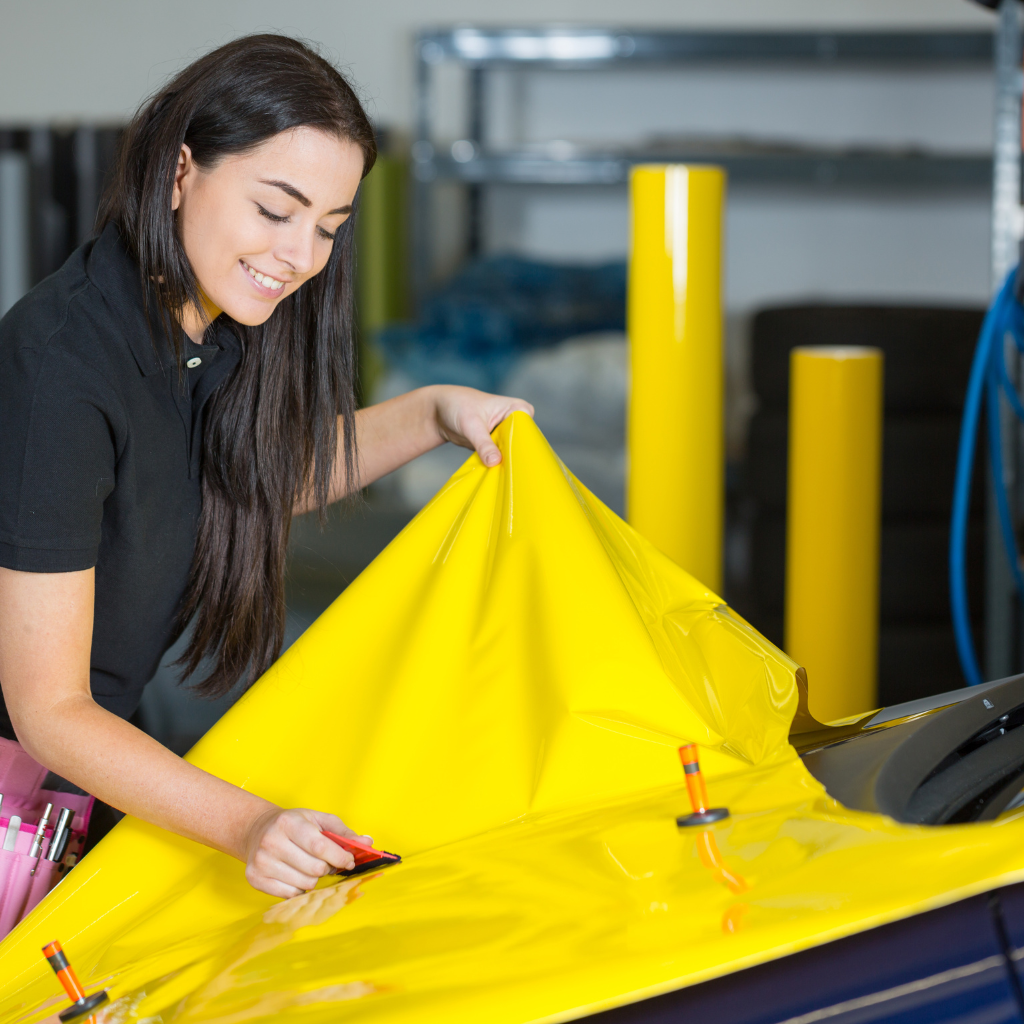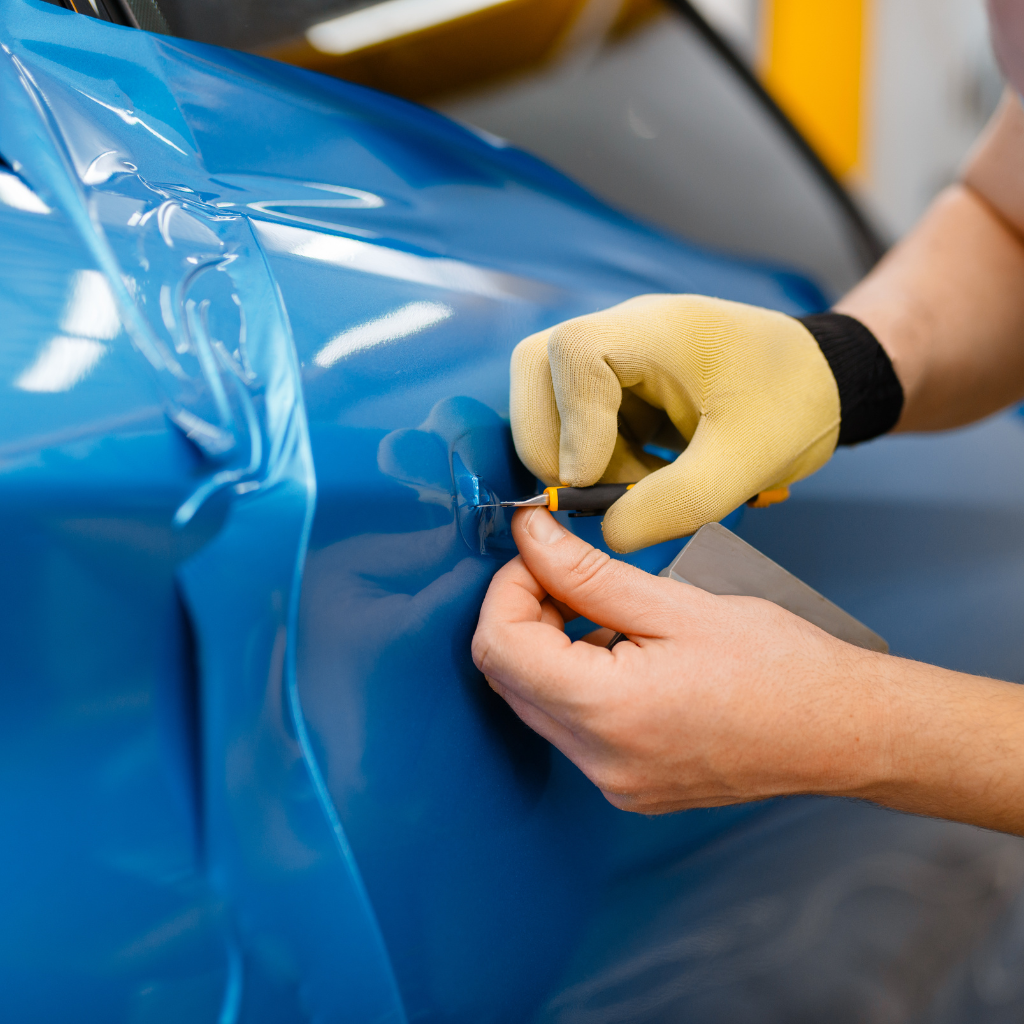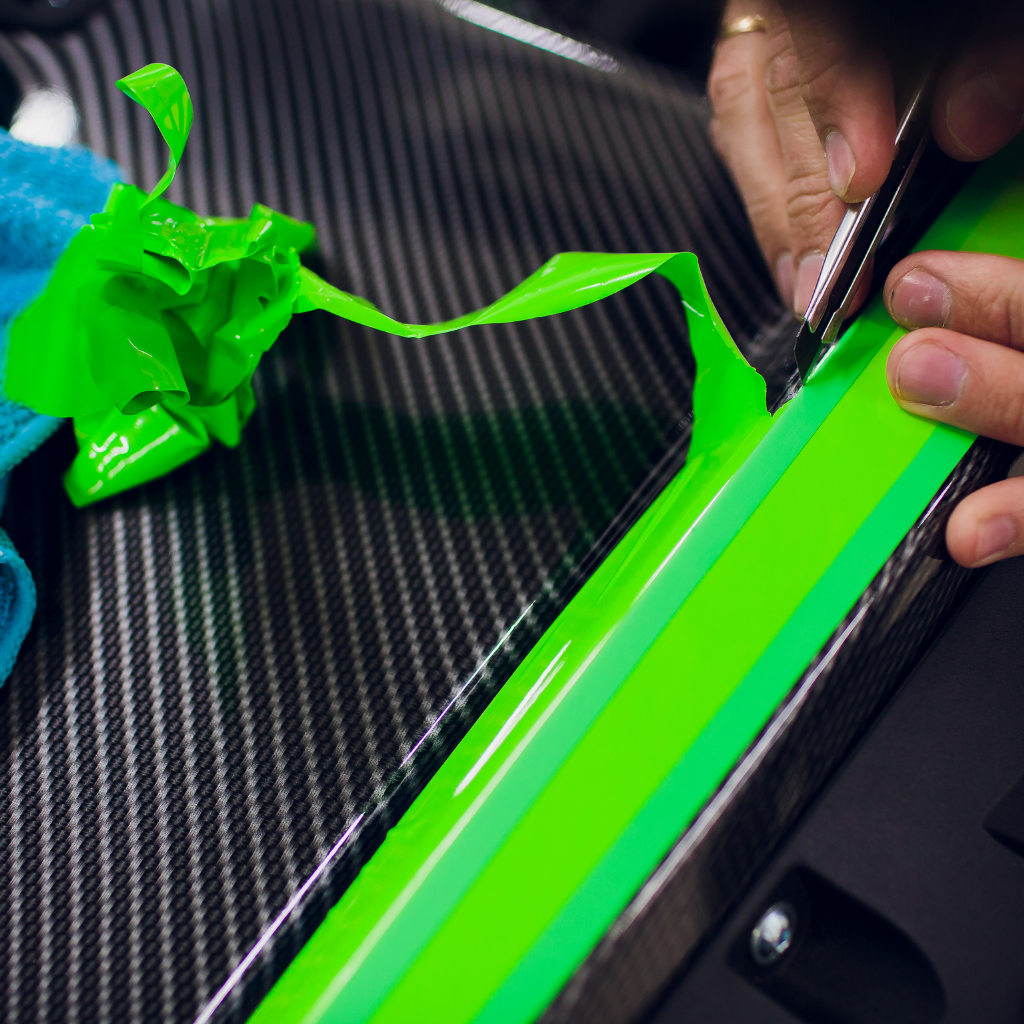The Ultimate Guide to Car Wraps: Protect Your Vehicle in Style
Many of how car wraps work because owners worry about keeping their vehicles looking brand new. Paint scratches and weather damage can quickly remove your prized possession’s shine. If you’re contemplating how to protect your car’s exterior without compromising on style, understanding how do car wraps work could be the solution you’re seeking.
One popular application for car wraps is advertising wraps, which are highly effective in displaying business branding, logos, and graphics. Custom wraps can enhance the vehicle’s aesthetics and advertise while driving, making them an economical and visually appealing option for businesses.
Vinyl wrap offers a protective layer that guards against UV rays, dirt, and minor dents whilst giving your vehicle a fresh look. This article will guide you through the benefits and drawbacks of choosing a vinyl wrap for your car.
What is a Car Wrap, and How Does it Work?
A car wrap involves covering a vehicle in large vinyl decals. These can completely change the look of the entire car without altering the original paintwork. The process uses Polyvinyl chloride (PVC), a material that wraps around every inch of the whole car part’s surface.
This technique allows for custom graphics, advertising, or a new color. Vehicle wraps stick to cars with a strong adhesive but don’t harm the underlying paint. If you’re considering a custom look for your car, exploring perfect vehicle wrap design ideas can help you find inspiration that reflects your personal style or business branding goals.
While wrapping can protect the original paint from scratches and UV damage, improper application or removal can lead to damage. Understanding the impact of car wraps on paint is crucial, and professional installation helps avoid issues like scratches or peeling during removal.
The application of a vehicle wrap begins with cleaning the car’s surface to remove any dirt and grime. Then, specialists apply the vinyl using heat guns to mould the material around curves and edges, ensuring a smooth finish without wrinkles or air bubbles.
The durability of these wraps varies based on factors like exposure to harsh weather and how often you wash your car but typically lasts five to seven years. Car wraps offer an innovative way to protect your vehicle’s original paint while showcasing your style or brand.

Understanding the Basics of Vinyl Car Wrap
Vinyl car wrap is a popular method of changing the appearance of your vehicle without committing to a full respray or paint job. The process of vehicle wrapping involves applying a vinyl film to the car’s surface, which can be used to change the colour, add a design or pattern, or even protect the original paintwork. Car wraps are available in various finishes, including metallic, matt, and gloss, and can be applied to the entire car or just one or more panels.
This technique allows for a high degree of customization, enabling car owners to experiment with different looks without making permanent changes. Whether you want a sleek metallic finish, a bold matt look, or a high-gloss shine, vinyl car wraps offer a versatile solution. Additionally, vehicle wrapping is reversible, meaning you can return to the original paintwork or switch to a new design whenever you like.
How Does a Wrap Protect Your Car’s Paint?
A car wrap can provide a layer of protection for your car’s paint, shielding it from minor scratches and chips. The vinyl film is designed to absorb impacts and prevent damage to the underlying paintwork. Additionally, car wraps can protect your car’s paint from UV damage, which can cause fading and discoloration over time. However, it’s worth noting that car wraps are not a substitute for proper paint protection film and should not be relied upon as the sole means of protecting your car’s paint.
The protective benefits of a car wrap extend beyond just physical damage. By blocking harmful UV rays, the vinyl film helps maintain the vibrancy and gloss of your car’s original color. This is particularly beneficial for vehicles frequently exposed to sunlight, as it prevents the paint from fading and keeps your vehicle looking newer for longer.
The Role of Adhesive in Vehicle Wrap Application
Understanding the significance of adhesives in vehicle vinyl wrap applications becomes vital when transitioning from the protective role of a car wrap. Adhesives guarantee that the wrap grips securely to the car, facilitating a smooth finish without impairing the initial paintwork.
Owing to technology’s progress, products have been developed that secure the vinyl under varying weather conditions, also enabling convenient removal when you choose to modify designs or return to the original paint.
This idea of equilibrium between resilience and removability is essential, aiding in maintaining your vehicle’s exterior in immaculate condition.
An apposite adhesive morphs a vinyl wrap into a staunch shield for your car.
Vinyl materials carry distinct and different types of adhesive backings suited to cater to particular application requirements, whether it’s for total coverage of a whole car or mere accents on panels of the roof and hood.
Certain advanced adhesives are developed to be activated by heat, allowing installers to stretch and shape the vinyl around turns and challenging areas without leaving creases or bubbles.
Applying these adhesives correctly demands proficiency and focus during installation, but results in a wrapped vehicle appearing flawless and enduring longer against elements like sun exposure, temperature fluctuations, and even automatic car washes.

How Long Do Wraps Last on a Car?
A car wrap can last five to seven years, depending on several factors. These include the quality of the wrap, the type of vinyl used, and how well you maintain it. Car wraps require proper care to extend their lifespan.
For instance, parking your vehicle away from direct sunlight helps prevent the vinyl from fading and peeling.
Proper maintenance involves regular cleaning with mild soap and avoiding harsh chemicals. If you use a pressure washer, do so carefully to prevent lifting the edges of the wrap. Signs that your car’s wrap needs replacement include fading colours, peeling edges, and visible wear and tear.
Giving your car a new look with a fresh wrap also protects its original paintwork beneath, adding to both its aesthetic appeal and resale value.

Factors Affecting the Lifespan of a Car Wrap
Several factors can affect the life of your car wrap. Understanding these factors will help you get the most out of your investment in vinyl wraps.
- Quality of vinyl used: High-quality vinyl lasts longer than cheaper alternatives.
- Expertise of the installer: Skilled professionals apply wraps correctly, extending their lifespan.
- Sun exposure: Constant exposure to sunlight can fade and weaken the wrap over time.
- Frequency of car washes: Excessive washing, especially with harsh chemicals, can damage the wrap.
- Type of car wash: Hand washes are gentler than automatic brushes, which can scratch and peel the wrap.
- Quality of care and maintenance: Regular waxing will protect the wrap from scratches and UV rays.
- Climate conditions: Extreme weather like hail or high temperatures can affect a wrap’s durability.
- Physical abrasions: Scratches or dings from parking lots or debris on roads can decrease a wrap’s lifespan.
- Use of chemical cleaners: Certain solvents and cleaners may break down the adhesive or vinyl faster.
- Proper installation techniques: Avoiding air bubbles and wrinkles during application prevents premature wear.
Considering these points, you can ensure that your decision to wrap your car results in a long-lasting, cost-effective makeover for your vehicle.
wraps endure on a vehicle enables owners to strategise for future upkeep or replacements effectively.

Signs Your Wrap Needs Replacement
Vehicle wraps are a smart way to change the colour of your car and help protect its paint. Over time, though, they can wear out and need replacing. Here’s how you know it’s time:
- Fading colours: Sunlight can make the vibrant colours of your wrap look dull.
- Peeling edges: The wrap may start lifting at the corners or along the edges.
- Cracking or bubbling: Heat causes the vinyl to crack or create bubbles underneath.
- Scratches and scuffs: Daily use can lead to marks that can’t be removed easily.
- Rust spots: If moisture gets under the wrap, it might cause rust on the metal beneath.
- Outdated advertising: For businesses using wrap advertising, messages need updating to stay relevant.
- Warranty expiration: Most wraps come with a warranty. It might be time for a new one if yours has expired.
Let’s look into how long you can expect a quality car wrap to last.
Pros and Cons of Car Wraps
Choosing to wrap a car brings several advantages, including protection against scratches and dings. Vinyl wraps act as a shield for the paint underneath, helping preserve the vehicle’s appearance while offering an aesthetic change.
This method allows car wrapping enthusiasts to experiment with different colours and finishes, such as gloss or metallic, without committing to a full respray. Car wraps can be applied to the entire colour of a car or just specific parts like the hood, providing flexibility in design.
However, the potential downsides of car wrapping cannot be ignored. The lifespan of a car wrap varies; although it can last up to five years with proper care, environmental factors such as excessive sun exposure can shorten this period.
The application requires skill and precision; poor installation might lead to wrinkles and air bubbles that tarnish the look of your vehicle. Finally, removing or replacing a wrap demands time and additional cost should you decide on another colour or return to the original paintwork.
Advantages of Using Vinyl Car Wrap
Vinyl car wraps offer a brilliant way to give your car a fresh and exciting look without the permanent commitment of a more expensive respray can. These wraps protect the paint underneath from scratches and dings, keeping your vehicle looking pristine for longer.
They are handy for business owners using them as mobile billboards to boost brand visibility. The vinyl wrap material acts like a second skin for the car, shielding it from frequent minor damages.
Experts in car wrap can apply these vinyl wrap layers with precision, ensuring that every curve and edge of your bodywork is covered seamlessly. Available in various finishes, including gloss, matte, and metallic, automobile enthusiasts can customise their vehicles according to personal taste, budget, or corporate branding needs.
Wraps also have an impressive lifespan but can be removed or changed when desired without harming the original paint job.
Using a heat gun during application ensures that the wrap is applied perfectly flat against the surface of your car’s hood and other parts.

Potential Downsides to Consider Before You Wrap Your Car
Moving from the benefits of vinyl car wraps, it’s crucial to address some concerns that might arise. Wrapping a car changes its appearance without altering the original paintwork. However, this process isn’t without its drawbacks.
The initial cost of vehicle wrapping can be high, especially for high-quality materials and metallic finishes with enhanced gloss optics and durability. Also, poorly done wraps can harm your vehicle’s surface rather than help prevent damage.
It requires skilled car wrap experts to ensure proper application and avoid issues like peeling or bubbling.
Another point to consider is the care and maintenance of wrapped vehicles. Vinyl wraps need regular cleaning to maintain their appearance and protect against wear and tear. They are not as durable as traditional paint jobs in extreme weather conditions or against abrasive cleaning methods.
Over time, exposure to sunlight can fade the colours, reducing the vibrancy of your design choice. Moreover, when you decide it’s time for a change or removal, improper techniques can risk damaging the underlying paint protection film layer on your hood (car) or other metal surfaces.
How to Wrap a Car: Step-by-Step Guide
Wrapping a car provides a fresh look while protecting the original paint. This process involves applying a thin layer of vinyl that can significantly change your vehicle’s appearance.
- Choose the suitable vinyl wrap. Options vary from matte to high gloss (optics), and each type offers different durability and aesthetics.
- Clean the car thoroughly. Dirt or grease on the surface will prevent the adhesive from bonding correctly.
- Remove any fixtures that might get in the way, like wing mirrors and door handles, to ensure smooth application around curves and edges.
- Measure the panels of your car carefully. Accurate measurements are crucial to cutting the vinyl precisely, avoiding waste and ensuring complete coverage.
- Cut the vinyl according to your measurements. Leave some extra material at the edges; trim it later for a perfect fit.
- Apply an application fluid to prevent the vinyl from sticking immediately, allowing some repositioning if needed.
- Place the vinyl over the target area and use a squeegee to smooth it out, removing air bubbles and wrinkles.
- Use a heat gun gently over areas with curves and contours to make the vinyl more pliable and stretch into place without tearing.
- Trim excess material carefully with a sharp blade for clean edges around fixtures, ensuring no damage to the vehicle’s paint underneath.
- Once applied, heat the entire wrapped area again to activate the adhesive fully and remove any remaining air pockets.
The process demands patience and attention to contact details but results in a stunning visual transformation that acts as plastic armour for your car’s original finish.
Preparing the Car’s Surface for Vinyl Wrap
Crucial to the successful application and longevity of a vinyl wrap on a car is the initial preparation of the car’s surface. The preparatory stage of vehicle wrapping kicks off with a comprehensive vehicle cleaning to rid it of dirt, grime, and any residues that may hinder the vinyl’s ability to adhere.
Particular attention should be given to edges, seams, and crevices, notorious for trapping dirt. Following washing, a clay bar treatment is employed to lift any lingering impurities that a standard car wash alone may have missed from the paintwork.
Professionals often use a specially formulated solution to provide a further level of deep cleaning and degreasing of the surface. Any necessary repairs or sanding processes should be carried out prior to this step, as vinyl highlights flaws rather than disguising them.
Once the car wash is fully dry and the surface is devoid of any contaminants, it is all set for the first step of the car wrapping up process. These preliminary stages demand patience, ensuring a professional-looking finish that can withstand daily use.

Application Process: How the Wrap is Applied
Experts start applying the wrap after preparing and wrapping the vinyl, and the car’s surface is begun. They use a unique adhesive to fix the vinyl onto the vehicle. This process requires skilled hands to ensure no air bubbles or wrinkles form.
The team stretches and positions the vinyl, cutting excess material for a perfect fit.
They heat the vinyl during application. This makes it more flexible and more easily moulded around curves and edges. Each section or panel of the vehicle gets individual attention, guaranteeing a smooth finish that looks like paint.
Professionals must work carefully to avoid damaging the car’s original paint beneath.
Can a Wrap Be Used for Paint Protection?
Car wraps protect your car’s paint against scratches, dings, and weather damage. Made from durable vinyl, they act as a barrier between the paint and harmful elements like UV rays and road debris.
This protection helps maintain the car’s appearance and can increase its resale value over time. Business owners who use their vehicles for branding find this especially beneficial as it keeps their mobile advertisements looking pristine.
Vinyl wrap does more than just protect; it also allows for easy customisation of the vehicle. Unlike resprays that are permanent, you can remove or change your car’s colour wraps without damaging the original paintwork underneath.
This feature presents an ideal solution for automobile enthusiasts wanting to update their vehicle’s look while preserving its integrity. The flexibility to switch designs or return to the original colour makes vinyl wrap a versatile choice for personalising cars without compromising their protection.
The Relationship Between Car Wrap and Paint Job
A car’s colour wrap is a protective barrier for the underlying paint. It defends against scratches, weather damage, and UV rays potentially causing the paint to fade gradually. Numerous drivers opt for vinyl wraps as a method to personalise their vehicles and to protect the original paintwork, ensuring it stays in undamaged and original condition beneath.
Consequently, wraps provide a beneficial avenue for retaining a vehicle’s resale value and simultaneously permit owners the freedom to modify their car’s aesthetics with no lasting alterations.
Vinyl wraps also benefit when contemplating total vehicle protection instead of classic resprays. Respraying necessitates removing the original paint, which is expensive and irreversible.
Conversely, wrapping proposes a reversible alternative that safeguards and maintains the underlying paint job, offering reassurance for owners who may wish to revert or vend their vehicles later.
How Vinyl Wrap Prevents Scratch and Ding
Vinyl wrap acts like a shield for your car’s paint. It car covers the surface with a protective layer that can absorb impacts from small debris, stones and even minor accidents, preventing scratches and dings.
This method benefits business owners and event organisers who must keep their vehicles in top condition. Keeping cars scratch-free isn’t just about aesthetics; it maintains the vehicle’s value over time.
The process involves applying a thin film of vinyl over the colour of a car’s body. This film sticks directly to the paint, creating a barrier against external elements. This protection is invaluable for automobile enthusiasts who often expose their vehicles to harsh conditions.
The vinyl is durable and withstands weather conditions without peeling or lifting. Car enthusiasts find peace of mind knowing their prized possessions are protected while showcasing an impressive exterior.

Conclusion
Opting to encase your car requires deliberate consideration. Evaluate your requirements and the advantages you seek. Car wraps provide safeguarding and aesthetic appeal, yet they also accompany a few pros and cons.
Corporate proprietors and event coordinators deem them beneficial for promotion. Car aficionados appreciate the unique appearance without enduring modifications.
Be sure to grasp the method to maintain your wrap. This will extend its lifespan. If uncertain, reach out to professionals who hold expertise in vinyl wraps. They can furnish counsel adjusted to your circumstances, helping you weigh the pros and cons effectively.



